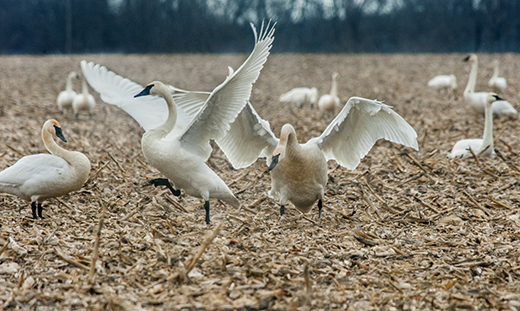Trumpeter Swans return

Trumpeter Swans, hunted to near extinction, are returning to Central Illinois where there have been several local sighting. These swans are in a field near Emiquon Preserve. With a wingspan of 7 feet, these native waterfowl are the rarest of the three species of swans in the United States.
With a wingspan of over 7 feet and weighing close to 30 pounds, the Trumpeter Swan is considered the largest native waterfowl species in North America. It is a bird that once nested across the upper United States and Canada, including Illinois. By the end of the 19th century, the Trumpeter Swan was thought to be extinct. Today, you can see this bird once again, taking to the skies in the upper Midwest. There have been several local sightings already since mid-November, and visitors should be able to find them in our marshes and backwaters for most of the winter.
There are three species of swans in the United States, so it takes some practice to tell one from the other. The rarest of the three is the Trumpeter Swan; a large, all-white bird with a black bill. More common and widespread is the Tundra Swan; another native species that is a little smaller than the Trumpeter and also has the black bill, but there usually is a yellow spot in front of the eyes. Finally, the third species of swan we have is an introduced species known as the Mute Swan, which has an orange bill with a black knob near the forehead. The Mute Swan is the most common of the swans found in Central Illinois, and they tend to be year-round residents. When you see the Mute Swan swimming, it has a gracefully curving neck. Both the Tundra and Trumpeter Swans tend to keep their necks straighter when swimming.
The story of the Trumpeter Swan’s decline is an all-too familiar tale. Throughout the 1800s they were market hunted for their meat. They were also used in the hat industry for their feathers. The soft swan skin was used in manufacturing powder puffs to apply make-up. Just to give you an idea of the impact of this, The Hudson Bay Fur Company shipped over 26,000 swan skins to England between 1804 and 1819. The overhunting, combined with habitat loss lead to the rapid decline of the species. By 1900, it was thought that the species was extinct. Fortunately, a small, non-migratory population was found in remote mountain valleys of Montana, Idaho and Wyoming. Two nests were found in Yellowstone National Park in 1919. In 1935, the Red Rock Lake National Wildlife Refuge was established to protect the remaining Trumpeter Swans, and the population increased to 640 birds by the late 1950s. Also in the 1950s, aerial surveys of the remote Copper River in Alaska found another population of Trumpeter Swans. This provided crucial genetic diversity to help expand the breeding success of the Red Rock Lake National Wildlife Refuge population.
In the upper Midwest, Trumpeter swans were reintroduced into Minnesota from the Red Rock Lakes population. The population recovery has been a slow and costly process. Several rises and falls in the population have happened in the years since the recovery effort has expanded into the upper Midwest. New threats were found in the modern landscape. Swans were severely impacted by lead poisoning caused by ingesting lead shot that can be found in hunted wetlands. But by the early 1990s the upper Midwest population had grown to 600 birds. In the 2000s, we did see large growth in Trumpeter Swan populations. The Minnesota reintroduction expanded into Wisconsin and Michigan and in 2015 it is estimated that over 27,000 birds now make up what has been called the “Interior Trumpeter Swan Population.”
It is a dramatic and heartening recovery. It took a lot of work by both private conservation groups and federal agencies to bring this magnificent bird back from the brink of extinction. It is a conservation success story that is somewhat overlooked. To get a glimpse of these birds, get out to some of our local wetlands to find them. Look at Banner Marsh in southern Peoria County, which always has a lot Mute Swans, but the Trumpeter and Tundra swans can also be seen there. The same is true for Spring Lake in southern Tazewell County, Chautauqua National Wildlife Refuge in Mason County and Emiquon Preserve in Fulton County.
Winter is not a bad time to visit our wetlands. At least the swans think so. Go out and welcome them back to their former home. Who knows, if they feel welcome enough, maybe they will once again nest here.

Recent Comments